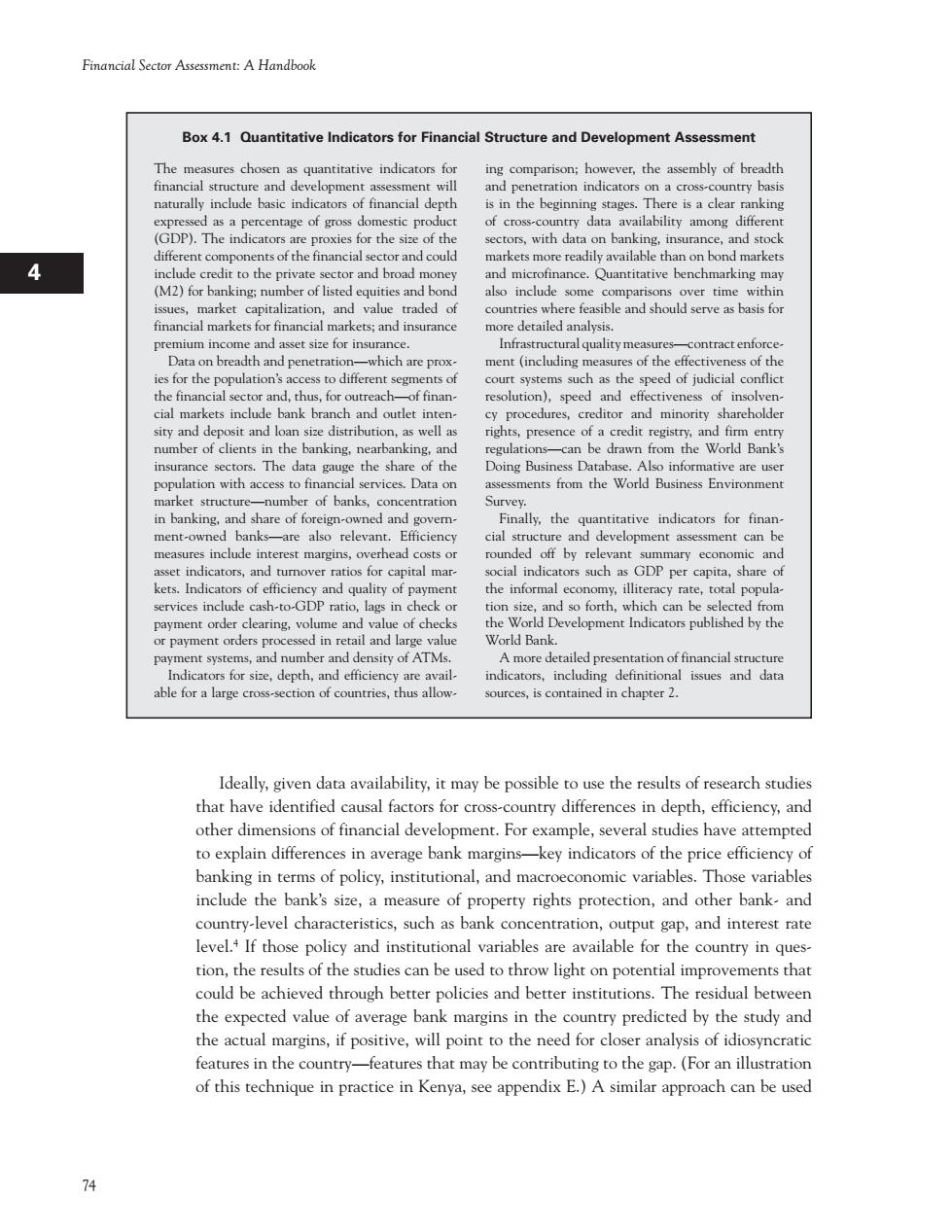正在加载图片...

Financial Sector Assessment:A Handbook Box 4.1 Quantitative Indicators for Financial Structure and Development Assessment The meas penetration indicat y with d and s 4 (M2)for lude some more detailed analysis ontract ento of the a ourt systems such as the dof judicial co tion),spee ctiveness of it and loan sie distribution,as well as rights,presence of a credit registry,and fimm entry -c an be drawn from e World Bank nents from the World Business Environment number of banks, ally th ment-owned banks are also relevant.Eficienc overhead costs c off by relevant s mmary economic and the informal cco nomy.illit arate total popul services include cash-to-GDP ratio lags in check c h can be World Bank. umber and more de able for aa oof countries,thus allow sources.is contained in chapter 2. Ideally,given data availability,it may be possible to use the results of research studies that have identified causal factors for cross-country differences in depth,efficiency,and other dimensions of financial development.For example,several studies have attempted in average bank margins-key indicators of the price effici banking in terms of policy,institutional,and macroeconomic variables.Those variable include the bank's size,a measure of property rights protection,and other bank-and country-level characteristics.such as bank concentration.output gap,and interest rate level Ifthose policy and for the tion,the results of the studies can be used to throw light on potential improvements that could be achieved through better policies and better institutions.The residual between the expected value of average bank margins in the country predicted by the study and the actual margins,if positive,will point to the need for closer analysis of idiosyncratic ures in the country-fearures that may be contributing to the gap.(For an illustratior of this technique in practice in Kenya,see appendix E.)A similar approach can be used 74 Financial Sector Assessment: A Handbook 1 I H G F E D C B A 12 11 10 9 8 7 6 5 4 3 2 Ideally, given data availability, it may be possible to use the results of research studies that have identified causal factors for cross-country differences in depth, efficiency, and other dimensions of financial development. For example, several studies have attempted to explain differences in average bank margins—key indicators of the price efficiency of banking in terms of policy, institutional, and macroeconomic variables. Those variables include the bank’s size, a measure of property rights protection, and other bank- and country-level characteristics, such as bank concentration, output gap, and interest rate level.4 If those policy and institutional variables are available for the country in question, the results of the studies can be used to throw light on potential improvements that could be achieved through better policies and better institutions. The residual between the expected value of average bank margins in the country predicted by the study and the actual margins, if positive, will point to the need for closer analysis of idiosyncratic features in the country—features that may be contributing to the gap. (For an illustration of this technique in practice in Kenya, see appendix E.) A similar approach can be used Box 4.1 Quantitative Indicators for Financial Structure and Development Assessment The measures chosen as quantitative indicators for financial structure and development assessment will naturally include basic indicators of financial depth expressed as a percentage of gross domestic product (GDP). The indicators are proxies for the size of the different components of the financial sector and could include credit to the private sector and broad money (M2) for banking; number of listed equities and bond issues, market capitalization, and value traded of financial markets for financial markets; and insurance premium income and asset size for insurance. Data on breadth and penetration—which are proxies for the population’s access to different segments of the financial sector and, thus, for outreach—of financial markets include bank branch and outlet intensity and deposit and loan size distribution, as well as number of clients in the banking, nearbanking, and insurance sectors. The data gauge the share of the population with access to financial services. Data on market structure—number of banks, concentration in banking, and share of foreign-owned and government-owned banks—are also relevant. Efficiency measures include interest margins, overhead costs or asset indicators, and turnover ratios for capital markets. Indicators of efficiency and quality of payment services include cash-to-GDP ratio, lags in check or payment order clearing, volume and value of checks or payment orders processed in retail and large value payment systems, and number and density of ATMs. Indicators for size, depth, and efficiency are available for a large cross-section of countries, thus allowing comparison; however, the assembly of breadth and penetration indicators on a cross-country basis is in the beginning stages. There is a clear ranking of cross-country data availability among different sectors, with data on banking, insurance, and stock markets more readily available than on bond markets and microfinance. Quantitative benchmarking may also include some comparisons over time within countries where feasible and should serve as basis for more detailed analysis. Infrastructural quality measures—contract enforcement (including measures of the effectiveness of the court systems such as the speed of judicial conflict resolution), speed and effectiveness of insolvency procedures, creditor and minority shareholder rights, presence of a credit registry, and firm entry regulations—can be drawn from the World Bank’s Doing Business Database. Also informative are user assessments from the World Business Environment Survey. Finally, the quantitative indicators for financial structure and development assessment can be rounded off by relevant summary economic and social indicators such as GDP per capita, share of the informal economy, illiteracy rate, total population size, and so forth, which can be selected from the World Development Indicators published by the World Bank. A more detailed presentation of financial structure indicators, including definitional issues and data sources, is contained in chapter 2